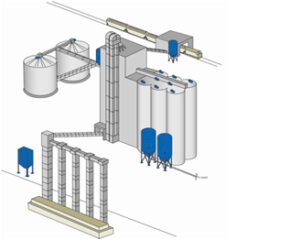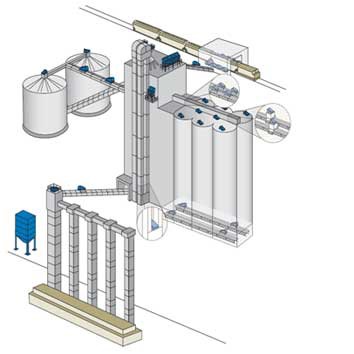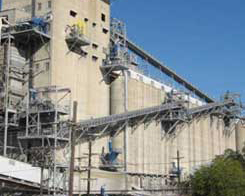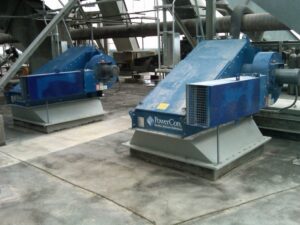An Optimized Approach to Dust Control in Grain Elevators and Terminals
Every time grain is moved from one place to another, dust is generated. This dust must be controlled, captured, and contained.
By Geronime/Boston/McGovern/Abelson
Dust is Created Every Time Grain is Moved
Over 18 billion bushels of grain are produced and moved through grain handling systems in the US each year. The ability of the United States to feed its populace and livestock, support the biofuels movement, and export excess grain to emerging markets is a point of national pride and strength. The infrastructure for moving grain from one point to another includes small country elevators, larger elevators, large grain terminals, trucks, trains, barges, and ocean going shipping vessels. And every time grain is moved from one of these points to another, dust is generated. Dust which must be controlled, captured, and contained.
Trends
There are a number of trends that affect strategies for dust control in the grain industry.
Aging Facilities
At the top of this list is the fact that most existing grain handling facilities are now almost thirty years old, having been constructed during the 1980s. Now thirty years later, the U.S. is trying to move twice the amount of grain through the same fixed assets, creating a strong and increasing demand to implement process solutions that will improve uptime and reliability. Where possible, it is desirable to avoid building new infrastructure when improvements to the existing infrastructure could support the capacity needs.
When simple improvements are not enough, more substantial investments are being made to revitalize aging facilities with updates, expansions, or even the building of new facilities. With new investments comes a new focus on process improvement to eliminate waste streams, improve product quality, and improve energy efficiency. The goal is not simply to replace an aging infrastructure; the goal is to improve it.
Competition between grain trading companies is also fueling the need to substantially improve existing facilities. On the Columbia River, where the grain industry’s first new export terminal in 30 years is nearing completion, several nearby grain terminals have either embarked on or will soon embark on projects intended to improve their grain handling capacity and efficiency. Without these investments, the new terminal has a substantial market advantage over the existing terminals and could undoubtedly leverage that advantage to acquire market share.
Tighter Local Regulations
Another trend is a greater focus on dust emission issues. While federal regulations for grain dust emissions have not changed substantially in many parts of the country, some areas (like the West Coast) are experiencing tighter emission standards and increased enforcement. Even in areas where regulated emissions have not changed, emissions are still an issue because of encroachment. As neighbors move closer to grain handling facilities, general tolerance for dust emissions decreases so grain handlers need to be more concerned about emissions.
Managing Combustible Dust
Finally, local and pending federal regulations regarding the management of combustible dust may be substantially different from past best practices. Dust control is more important than ever to grain handlers as they seek to comply with upcoming OSHA regulations intended to prevent catastrophic combustible dust events.
How Trends Affect Dust Collection Stratagies
To summarize, the major trends that affect strategies for dust collection in the grain industry include:
- Increased material throughput
- Protection of market competitiveness
- Improved uptime and reliability
- Desire to eliminate waste streams and improve product quality
- Focus on energy efficiency as a profit driver
- Need to reduce dust emissions to meet tighter standards and to manage encroachment issues
- The anticipation of regulations for managing combustible dust
New Dust Control Solutions
As industry trends push grain handlers to look at dust control as an integral part of their operations, the dust collection industry continues to provide solutions for those demands. In some instances, companies have applied solutions that follow age-old practices and approaches, while others have developed newer and more effective solutions to meet the new demands.
Point-of-Use Solution
One innovative approach to dust management is to collect and manage dust at the point of generation – at the source. Capturing and controlling dust at its source provides several benefits including:
Reduction or Elimination of waste streams.
Reduction or Elimination of waste streams. When captured dust is retained within the process generating it, it stays as part of the revenue producing product stream. Instead of turning a portion of the product into a pile of wasted dust, it remains as part of the product stream that has economic value.
Reduction or Elimination of waste stream equipment.
Reduction or Elimination of waste stream equipment. When dusts produced in a process are separated from the original process stream, they require independent material handling equipment and process equipment. Keeping the dust within the product stream minimizes the cost and maintenance of additional material handling equipment.
Minimizing the number of duct runs.
Minimizing the number of duct runs. It takes a tremendous amount of energy to move dust-laden air through long duct runs. Installing point-of-use dust collectors closer to the dust-generating process minimizes or eliminates unnecessary ducts, which saves energy.
Reduced duct maintenance.
Reduced duct maintenance. Minimizing duct runs reduces maintenance costs, eliminates wasted air from leaks in the duct system and eliminates costly lining of ducts.
Easier installation.
Easier installation. Less ducting also equates to a simpler and easier installation for dust collection equipment. Smaller, lighter collectors mean less support infrastructure in grain handling facilities where collectors are often not placed on the ground.
Improved uptime and reliability for the system as a whole.
Improved uptime and reliability for the system as a whole. With centralized dust collection, when a dust collection system requires servicing the entire dust handling system, and often the entire grain handling facility must be shut down to resolve the problem. With a series of point-of-use collectors, when an individual leg of the process is taken offline for maintenance, the rest of the system continues to operate. This provides a level of redundancy to the system, leading to improved uptimes for the facility. Other potential benefits of point-of-use collectors include:
- Minimizing impact on uptime due to servicing – minimize downtime to allow more flexibility in servicing scheduling (20 minute cycle vs. 4-8 hours); design characteristics that simplify and speed servicing actions.
- Localized systems minimize the impact on total operations when a single component has issues.
- Localized systems improve energy utilization, allowing operations to use energy only when needed to manage dust in each area. This approach eliminates wasted energy used to pull air from areas not handling dust.
- Technologies that extend filter life to reduce service frequency
Point-of-Use Requires a Smaller Footprint
Supporting a point-of-use innovative dust control solution requires a dust filtration product with a very small footprint, but with robust performance to handle moderate to large air volumes. Traditional bag houses and cartridge collectors are generally either too large for point of use installation, or when sized to fit, are unable to handle the necessary air volumes.
Newer products on the market, such as the Donaldson®Torit® PowerCore® CP-Series dust collector, work very well as a point-of-use source collector. As a small, light, easy to maintain collector capable of handling the required air volume, this product offers distinct advantages over the more typical bag house technologies, which have been in use for over 40 years.
Products like this offer the ability to collect materials at the source, and allow dust control with a more manageable investment in energy costs. Point-of-use collectors reduce air volume for dust control; reduce horsepower investment, and minimize operational energy costs. With its smaller size and low profile, the Torit PowerCore CP collector can be installed at multiple locations in new facilities as source collectors, and can squeeze into tight spaces in existing facilities (due to its smaller size) to solve nuisance dust problems.
New Media Options
Conventional baghouse media has always had a relatively low efficiency compared to the newer media options that can now help facilities meet the demand for reduced emissions and help manage encroachment issues.
For decades fine fiber media in cartridge-style dust collectors has provided higher levels of efficiency to processes where cartridge dust collectors are applied; however, cartridge dust collectors have not been ideally suited to most grain handling operations and consequently this efficient media has not been widely adopted. With the release of the Torit PowerCore CP-Series, more efficient Ultra-Web® fine fiber media is now available for the grain industry. Testing has shown emissions can be reduced by as much as 78% when Ultra-Web® fine fiber media is used. Ultra-Web® filter media in the Torit PowerCore CP-Series collector truly does represent the best available dust control technology for the grain industry.
When a facility is not in a position to replace centralized collectors, another strategy that helps to resolve some of the issues facing grain handlers is to upgrade the media used in their existing collectors. Dura-Life® bags last 2-3 times longer than standard bags and provide both energy savings and fewer emissions. Another option is to switch out standard bags for pleated bags. Ultra-Web SB pleated bag filters deliver longer filter life, higher efficiency, and cost savings for existing baghouse collectors. Pleated bags can help resolve bag abrasion issues and may allow more air through the collector by increasing the square footage of media.
Dust Control Solutions Comparison Example

To help understand the influence a point-of-use dust control strategy can have on facility’s operational costs, consider a typical grain elevator handling 40,000 bushels per hour of grain, transferring from rail to barges.
Figure 1 shows this typical elevator site with a conventional centralized dust control strategy. This facility would utilize 15 centralized bag house dust collectors, moving approximately 99,000 cfm of air anytime the facility is in operation, and the entire operation would need to shut down for periodic dust collector maintenance. These centralized systems would involve the installation of significant amounts of ducts adding to the installation and maintenance challenge for the facility. The energy costs for air movement alone in this centralized system could exceed $70,000 a year and additionally, the collected dust from the various bag house collectors would require expensive, maintenance-intensive material handling systems. This centralized approach also creates a lower value waste stream for the collected dust.



Figure 3 shows the same typical 40,000 bushel per hour elevator facility with a more contemporary approach leveraging point-of-use source capture in the dust control strategy. The facility would utilize 43 Torit PowerCore CP-Series point-of-use dust collectors and one bag house collector moving the same amount of air when all areas of the facility are running, but individual zones in the facility would be offline when certain processes are not running or when maintenance is required. Energy costs for this point-of-use strategy would approach $55,000 per year for an energy cost saving of almost 22% compared to a more traditional centralized strategy, just in air movement costs. In addition, the point-of-use approach does not generate the lower value waste stream. Collected dust is returned to the primary product stream and maintenance of extensive amounts of duct is reduced or eliminated in some areas.
In Figure 4 the point-of-use dust control strategy was implemented at a major grain export terminal on the Gulf Coast. Figure 5 shows a close up of a point-of-use collector on a silo.
Understanding Best Practices

Note that knowledge of best practices is essential to applying a point-of-use strategy, including understanding how to properly select and apply point-of-use equipment. As an example, point-of-use collection directly on the legs of a bucket elevator is not recommended, however a properly selected and designed point-of-use collector can allow captured dusts to be returned to the boot of the elevator offering the benefits of point-of-use source collection in a manner compliant with most standards.
Summary
The combination of a point-of-use dust management strategy and Torit PowerCore CP-Series collectors for dust control in the grain industry represents a best-in-class dust management strategy for meeting the changing expectations and requirements in the industry. The technology has proven itself in numerous grain installations in the U.S. alone and constitutes what should be considered, the best available dust control technology. We anticipate leading grain handlers will increasingly consider point-of-use dust collection technologies in their operations.

AST Canada has been helping clients find solutions for their unique Dust, Mist & Fume Collection needs for more than 40 years.
We can help you too.
